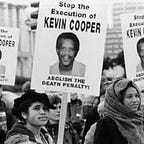Facts that ‘Death Row Stories’ didn’t include about the Kevin Cooper case
Sunday night’s episode of the CNN docuseries Death Row Stories raised serious questions about whether Kevin Cooper was framed by the San Bernardino Sheriff’s Department and the prosecution. Here are a number of additional facts DRS didn’t have time to include in that episode:
1. Christine Slonaker was not the only person to see three white men covered in blood at the Canyon Corral Bar the night of the Ryen/Hughes murders. Two more witnesses, Mary Wolfe and Lance Stark, who the Sheriff also never questioned, testified in 2004 that they saw these three white men, one of whom was wearing coveralls, in the bar that night and they also saw the blood on them. When Cooper’s attorneys identified Stark as a witness in 2004, the Sheriff’s Department went to his job site and told him it would be in his best interest not to testify in Cooper’s hearing.
2. When the Ryen/Hughes murders were discovered, the Sheriff’s Department contaminated the crime scene by allowing over 70 people to walk through the Ryen house. The trial judge said in open court that he could have done a better job investigating the crime scene than the Sheriff’s Department did.
3. District Attorney Kottmeier ordered the Ryen bedroom/crime scene to be dismantled even before Sheriff’s investigators could collect blood and other evidence that could have proved how many people attacked the Ryens, whether the Ryens fought back, and how they died. When the Sheriff’s Department dismantled the Ryen’s bedroom down to the studs, they put the walls, floor and carpets into a non-airconditioned storage shed, resulting in all that evidence being effectively destroyed for forensic purposes. Kottmeier later admitted he “struck” the crime scene to impede the defense.
4. The tan “Fruit of the Loom” t-shirt with Doug Ryen’s blood on it found near the Canyon Corral Bar fit exactly the description of the tan t-shirt Diana Roper reported to the Sheriff’s Department Lee Furrow was wearing the night of the murders, including having a breast pocket. That’s the tan t-shirt that the State’s own testing expert reported in 2004 had heightened levels of blood preservative on it. This shows that Sheriff’s lab technician Daniel Gregonis planted Cooper’s blood on the tan t-shirt in 1999. When he learned his testing proved that Cooper’s blood was planted, the State’s expert suddenly “withdrew” his findings, claiming without explanation his lab was “contaminated.”
5. Soon after the Sheriff’s Department’s crime lab head, William Baird, testified at trial that the supposed bloody shoe prints were from prison issued shoes, the Sheriff’s Department fired him because he was a heroin addict who had been stealing heroin for personal use and for sale from the Sheriff’s Department evidence locker.
6. The San Bernardino Sheriff himself, Floyd Tidwell, was prosecuted a few years later for stealing over 500 guns from the Sheriff’s Department property room. He pleaded guilty to avoid going to prison.
7. When she learned that the prosecution was claiming that the “Pro Keds” shoes were specially made for prisons, the warden at the prison from which Cooper escaped notified the Sheriff’s Department that the shoes were not specially made for prisons but instead were available to the public at retail. The Sheriff never called her back, and the prosecution never informed the defense. Instead it presented evidence that the shoes were “special” institutional shoes anyway, which was conclusively proven to be false in 2004.
8. When the Ryen’s station wagon was found in Long Beach (which is Northwest of Chino Hills, not South on the way to Mexico), there was blood on the driver’s seat, the front passenger seat and the back seat. That matches the description of where passengers in the Ryen’s station wagon were seen according to by-standers the night of the murders and Diana Roper and her sister, Karee Kellison, when Lee Furrow returned home early the morning after the murders.
9. According to the prosecution at trial, the Sheriff’s Department consumed in testing one of the cigarette butts that was “found” in the Ryen station wagon. The prosecution claimed the same cigarette butt suddenly “reappeared” in 2001 when the prosecution agreed to do DNA testing. The “reappeared” butt was, however, twice as big as the dimensions of the butt that was supposedly found in the Ryen station wagon and earlier consumed in testing.
10. In 2004 a Sheriff’s Department supervisor testified that he approved the destruction of the bloody coveralls that Diana Roper turned over to the Sheriff’s Department shortly after the murders were discovered. This testimony showed not only that the Sheriff’s Department approved the destruction of the coveralls before they were tested and before Cooper’s defense knew about them, but that the Sheriff’s Deputy who testified at trial in 1984 was lying when he said he destroyed the coveralls on his own and without approval.
11. The prosecution claimed at trial that the motive for killing the Ryens was to steal their station wagon. But the evidence at trial was that the Ryens never locked their cars and always left their keys in them. The Ryen’s truck, parked in their driveway, was found in that condition. So stealing the Ryens’ station wagon could not have been the motive for killing them.
12. When 9th Circuit Judge William Fletcher wrote his dissent in 2009 that began “The State of California may be about to executed and innocent man,” five additional appellate judges joined in that opinion. Six additional judges joined in saying that Kevin Cooper had not had a fair hearing on his claims of innocence. Another appellate judge earlier said that she was “discomfited” by the loss and destruction of evidence, but she was constrained by federal statute from ordering a new trial. There has never before been a case in the United States where twelve appellate judges have questioned the outcome of a death penalty conviction.
For more information about Kevin Cooper’s case, visit http://freekevincooper.org.
